Introduction
Charlie Chaplin’s 1925 film The Gold Rush can be well discussed as the one of most outstanding examples of a classical editing technique’s successful deployment, because the manner of how director went about connecting film’s scenes together corresponds to the foremost convention of this particular editing-style, “To keep the action logical and continuous, there must be no confusing breaks in an edited sequence” (Gianetti, p. 136). In its turn, this explains why, despite the fact that there are many prolonged time-lapses to the story of Chaplin’s Tramp trying to make riches in Yukon, during the time of the famous Gold Rush; there is an undeniable spirit of a real-time genuineness to this story’s cinematic representation. In my paper, I will aim to substantiate the validity of this thesis at length, while also answering questions contained in the assignment.
Analytical Part
One of the major techniques used by movie-directors within the context of how they go about producing a particular film is editing. According to Gianetti (2001), “Editing is simply joining one strip of film (shot) with another. Shots are joined into scenes. On the most mechanical level, editing eliminates unnecessary time and space. Through the association of ideas, editing connects one shot with another, one scene with another, and so on” (p. 134). This technique evolved out of directors’ need to represent the film’s events/actions in a spatially condensed manner.
In the early days of cinematography, editing techniques used to be utterly simple. That is, they were often concerned with directors shooting film-scenes in one long shot in a single take. Nevertheless, as time went on, editing techniques were becoming ever more complex. This was reflected by the fact that movies began featuring more than one shot/take. In its turn, this has led to the development of three conceptually different styles of editing: realist, classical and formalist. The classical approaches to realist editing are sequence shots and cutting to continuity. These approaches are being concerned with directors’ strive to ensure the film’s spatial integrity – hence, ascertaining depicted events’ perceptional realism. Directors who aim to ensure film motifs’ psychological soundness, on the other hand, commonly utilize classical editing, associated with the so-called principle of classical cutting. In their turn, formalist directors commonly resort to the deployment of thematic montage and abstract cutting, as the foremost means of ensuring that viewers’ exposure to their films would cause them to gain a better understanding of directors’ aesthetic/ideological agenda.
The technique of editing is closely related to the technique of creating proper mise-en-scenes. Just as it is the case with providing a particular take/shot with the mise-en-scenic wholesomeness, the utilization of a particular style of cinematographic editing, on the part of directors, serves the purpose of underling the significance of the explored themes and motifs. This is the reason why, for example, directors who favor the formalist editing technique, commonly utilize the so-called ‘close form’ format of creating takes’ mise-en-scenes.
Given the fact that directors most commonly resort to the classical method of editing, in order to ensure a high dramatism of their movies’ themes and motifs, it does not come as a particular surprise that many classically edited movies feature a number of prolonged panoramic shots. Chaplin’s The Cold Rush is not the exception; in this respect – the film’s very opening (figure 1) features the scene of thousands of prospectors claiming up the mountain (00.01.08).
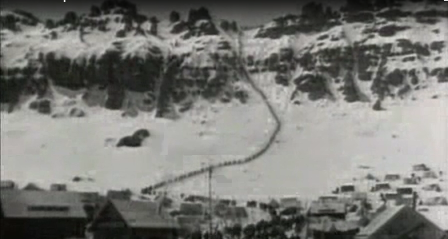
By having exposed viewers to this particular scene, Chaplin was able to endow them with a proper perceptional mood.
As was pointed out earlier, one of the classically edited movies’ foremost features is the fact that these movies depict the flow of events in a high realist manner. For that purpose, directors strive to ensure the spatial integrity of characters’ ‘motion,’ seen on the screen, “For instance, in a classically edited movie, a character moving from left to right in one shot will, for purposes of continuity, likely be shown moving left to right in an immediately subsequent shot” (Berliner & Cohen, 2001, p. 45). The watching of Chaplin’s The Cold Rush leaves very few doubts as to this suggestion’s full validity because his film features a number of spatially interconnected shots, which in turn help viewers to experience the sensation of a ‘spatial continuity’ while being exposed to film’s action. For example, in this particular shot (figure 2), the character of Tramp is shown walking in the right-wise direction (00.03.13):
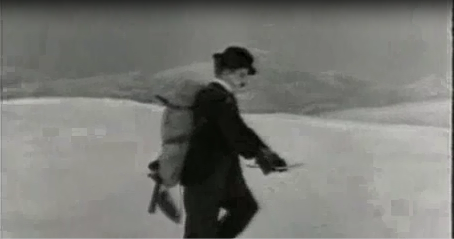
The subsequent shot (figure 3) shows Tramp coming out of the frame’s upper left corner and continuing to walk in the same direction (00.03.21):
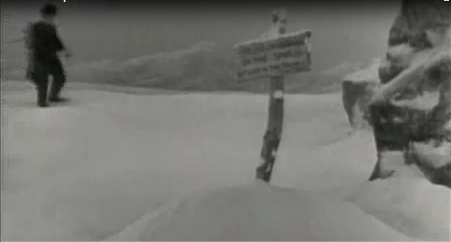
This, of course, helped viewers to perceive Tramp’s trip as such that proceeded through a number of consequential phases – just as it is being the case with people taking trips in reality. In its turn, this allowed the director to ensure the emotional appeal of a theme of Tramp walking through the snowy hills of Yukon – even though that there are strongly humorous defined undertones to this theme; it nevertheless emanates the spirit of realness. There is even more to it – by having utilized a continuity-cutting method to the consequential shots of Tramp’s trip, the director was able to conceal timely gaps to this particular theme. As it was pointed out by Smith, Levin, and Cutting (2012), “Filmmakers believe that by adhering to continuity-editing rules they can make a cut ‘invisible’ and ensure that ‘the spectator’s illusion of seeing a continuous piece of the action is not interrupted’” (p. 107). Even though that it must have taken at least a few weeks for Tramp to reach the cabin, and even though that this trip’s on-screen representation only takes a few minutes, viewers nevertheless perceive Tramp’s trip as thoroughly realistic, in the spatial sense of this word.
Another common feature of the classical editing methodology is the fact that this methodology is often being utilized within the context of directors aiming to ensure scenes’ emotional intensity, “Classical cutting involves editing for dramatic intensity and emotional emphasis rather than for purely physical reasons” (Gianetti, p. 138). This is the reason why the rationale behind the classical approach to film’s editing is often being concerned with directors’ conscious intention to emphasize the characters’ emotions. That is, directors make a deliberate point in enriching film’s action with the close-ups of characters’ facial expressions. For example, in the scene where hungry Tramp begins to chew on the bone (figure 3), which he found in the cabin, camera closes in on film’s main character, in order to allow viewers to get a glimpse of the whole range of emotions, seen on Tramp’s face (00.05.35):

By being exposed to this particular close-up shot, viewers get to realize that, during the course of his trip to the cabin, Tramp never ceased starving. As a result, Tramp’s behavior, throughout the film’s consequential parts, begins to make a perfectly good sense in viewers’ eyes – after all, it is only natural for those who have been deprived of food for a continuous period, to act in a somewhat whacky manner.
The fact that in The Gold Rush, Chaplin utilized a clearly defined classical editing-methodology can also be illustrated in regards to the scene, in which Tramp tries hard to remain on his feet while struggling with a strong wind that blows through the opened door (Figure 4 – 00.06.11):
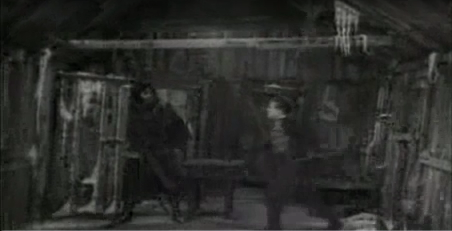
Apparently, this particular scene was meant to emphasize both: Tramp’s physical weakness and the strength of his resolution to actively resist life’s challenges, even while facing impossible odds. As it was noted by Bordwell, Staiger, and Thompson (1988), “Since the classical narrative depends upon psychological causality… surroundings become significant partly for their ability to dramatize individuality. The classical film charges objects (and nature’s emanations) with personal meanings” (p. 54). By exposing viewers to this scene, the director wanted to strengthen his film’s tragic-comic overtones. And, it needs to be said that he succeeded in it rather spectacularly – despite Tramp’s fragile physical appearance, we get to perceive him as a person endowed with a strong will-power.
The classical methodology of cinematographic editing is also unique with respect to its versatility. That is, along with featuring short and psychologically intense shots, classically edited movies often feature a number of spatially prolonged takes. For example, the take in which Tramp is trying to avoid being accidentally shot by either of two struggling prospectors, infected with ‘cabin fever,’ lasts for almost a whole minute (00.07.41- 00.08.30). In its turn, this can be explained by the fact that, while striving to ensure his film’s emotional appeal, Chaplin never ceased being aware of what accounts for another aspect of ascertaining movies’ ‘realness’ – namely, director’s talent in representing plot’s developments as they unravel, without making an excessive use of editorial cutting.
The classical style of movie editing is also notable in the respect that directors, who subscribe to its conventions, often use the so-called matching action technique. This technique is being concerned with directors arranging film’s consequential shots in a perceptually logical manner so that the shots’ actual cutting remains ‘seamless.’ For example, the shot in which Tramp’s ‘partner’ walks towards the door (Figure 5 – 00.20.14)
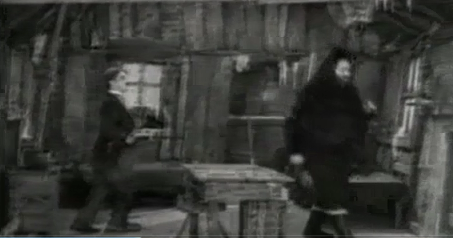
is being followed by the shot, in which we get to see him from behind (Figure 6) as if Tramp’s ‘partner’ walked in front of us and we have simply failed to notice that (00.20.15):
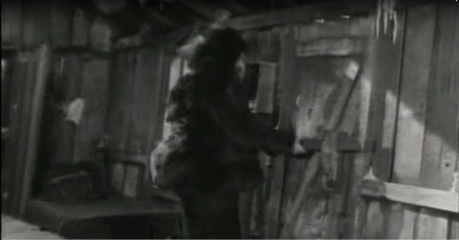
In other words, even though these two shots are being spatially separated (camera angles and mise-en-scenes are different), viewers nevertheless do not notice this inconsistency, as the utilized matching action technique ensures action’s ‘fluidness.’
Conclusion
Thus, it will only be logical, on our part, to conclude this paper by suggesting that the Chaplin’s film The Gold Rush does not only represent a high aesthetic/discursive value but that it also contains a number of clues as to what accounts for the cinematographic effectiveness of directors’ proper deployment of the classical editing-methodology. In its turn, this explains this particular movie’s cult status. Apparently, despite the fact that this film was produced in 1925, the psychological legitimacy of themes and motifs, explored in it, remains as ‘fresh’ as ever. This once again points out to Charlie Chaplin’s fame, like one of the 20th century’s most prominent film-directors and actors, as such that is being absolutely justified.
References
Berliner, T. & Cohen, D. (2011). The illusion of continuity: Active perception and the classical editing system. Journal of Film & Video, 63 (1), 44-63.
Bordwell, D., Staiger, J. & Thompson, K. (1988). The classical Hollywood cinema: Film style & mode of production to 1960. London: Routledge.
Chaplin, C. (Director). (1925). The Gold Rush [Motion picture]. United States: United Artists.
Giannetti, L. (2001). Understanding movies (9th edition). Upper Saddle River: Prentice Hall.
Smith, T., Daniel, L. & Cutting, J. (2012). A window on reality: Perceiving edited moving images. Current Directions in Psychological Science, 21 (2), 107-113.